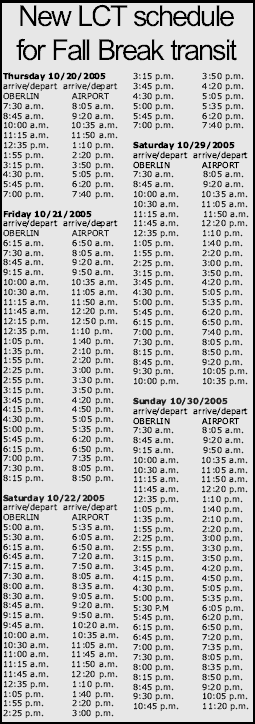
| << Front page | News | October 14, 2005 |
Students strive to revamp Lorain County Transit
 |
||
Students making plans to leave campus for Fall Break next week should be aware of, and excited by, the significant increase in the number of Lorain County Transit buses traveling to and from Hopkins International Airport on Route 33.
Oberlin Transit, a committee run by fifth-year Blaise Freeman and College sophomores Ezra Pincus-Roth and Nora Gordon, has been working hard this semester to make traveling more convenient and less frantic for Obies. The result has been LCT’s decision to include more buses on Route 33 to make stops at Oberlin more frequently.
The days with increased service will be Thursday, Friday and Saturday of next week, when most students are expected to be leaving Oberlin. There will also be increased service on the Saturday and Sunday at the end of fall break, Oct. 29 and 30, respectively, when many students will be returning to campus. With the exception of next Thursday, all of the other days of increased service, which are anticipated to have large numbers of student travelers, have buses making stops every 15 to 30 minutes.
To gauge students’ wants and needs for a reliable ride to the airport, Freeman said Oberlin Transit “used 2004 LCT ridership data to identify days with increased student demand for the academic year.
“Then we conducted over 150 in-person surveys about Fall Break travel plans,” he continued. “We then used the trends identified from this data to distribute around $4000 of extra buses across five days.”
Pincus-Roth added, “I also used my memory of personal experiences to help out. I remember the Friday morning before Spring Break when I had no choice but to take a cab because the bus wasn’t coming early enough to realistically make a flight. Coming from the West Coast, I assumed that I’m not the only one who has had to deal with this.”
“The general feeling among students appears to be that LCT is a joke,” he continued. “The current LCT website is the quintessential example of a bureaucratic throwaway that does nothing to help citizens in a meaningful manner. And how does one get to the Amtrak station? Thus, we took command and made an exclusive homepage within the College to answer most of these questions.
“Service within LCT should be better this time around. It’s only fair that it should be because now students have to pay fares.”
“We hope this revised schedule will be more convenient for a greater number of students, and we will continue to push for reliable service for the future,” Gordon added.
Getting LCT to commit to adding the extra buses, however, was not easy, according to Oberlin Transit.
“LCT was receptive to our suggestions but difficult to work with, as always,” Freeman said. “We expected to have a stand-by bus, [meaning a bus and a driver waiting in a garage in case extra support is needed], but then at the last minute LCT told us they couldn’t do stand-by after all. Instead we had to schedule all three buses on an inflexible schedule. Without the flexibility provided by a stand-by bus we had to commit to a schedule based on limited empirical research.”
In the end, however, Freeman, Pincus-Roth and Gordon are all pleased with LCT’s response to their concerns and are cautiously optimistic that the increase in service will make traveling less stressful come next week.
“I have high hopes that this service will be more accommodating, but I’ll only be happy with the results if LCT actually follows the schedule and sends adequate-sized buses to pick up all students,” Pincus-Roth said. “They have been given a fair warning from the College, and students are now contributing to the market with fares. If things don’t go to plan, then I’m going to be researching the possibility that the College take over some of the transit options for students in the future.”
Freeman added, “We are confident that service will be superior to previous years. We do not expect perfectly smooth service, however. Student demand may peak unexpectedly, and LCT does not have extra buses readily available if a bus breaks down. Hopefully, we won’t see any major problems Fall Break, but we want to be honest about their history of spotty service.
“Our greatest success has been working with the College, actually,” he continued.
“Our website looks professional and contains the content we wanted.
College administrators, deans and students have been very responsive and
helpful. We look forward to meeting with them more after Fall Break to expand
and relocate the website to provide even better service to students, faculty,
and community members in the future.”
About us
Subscriptions
Advertising